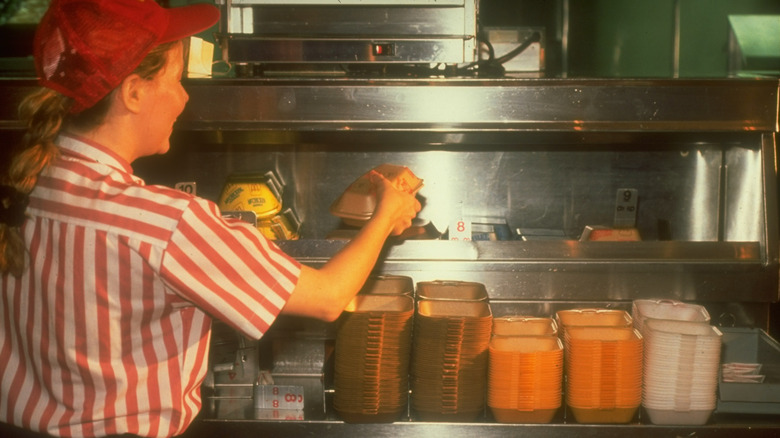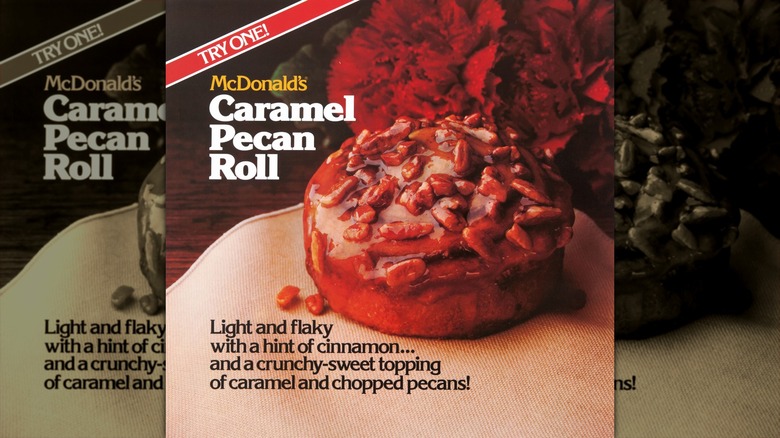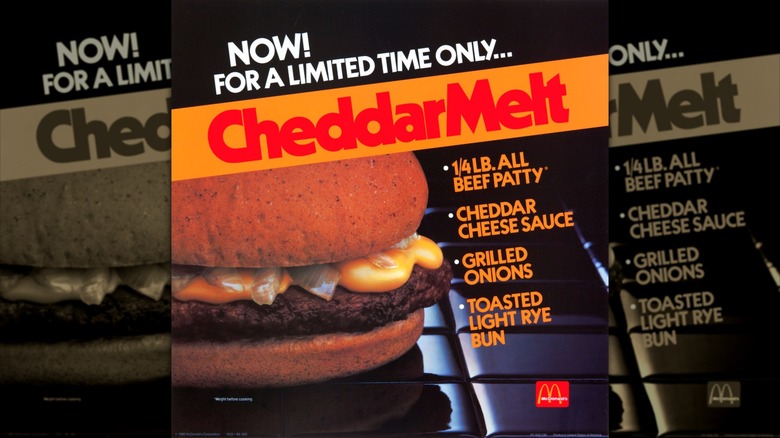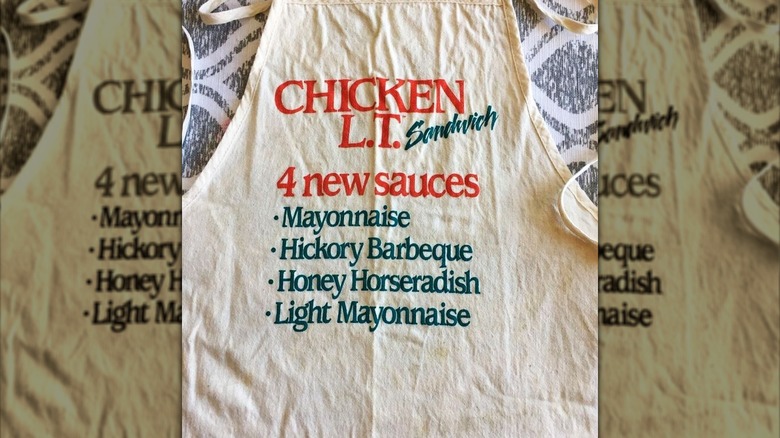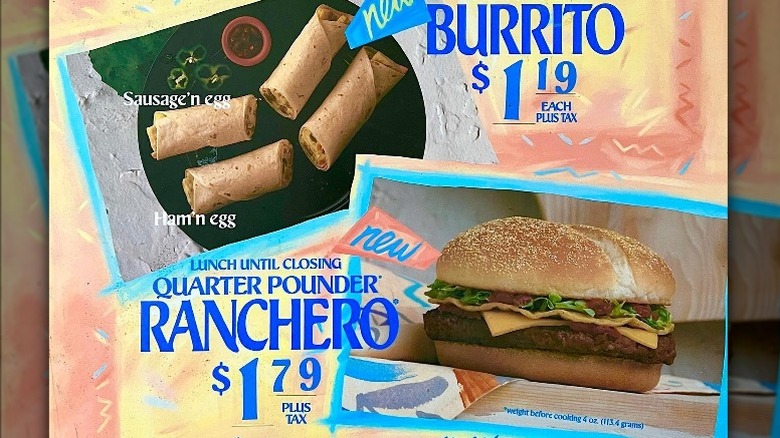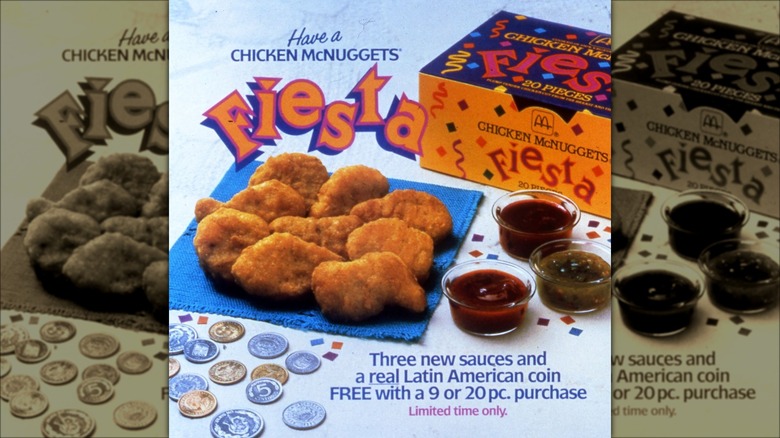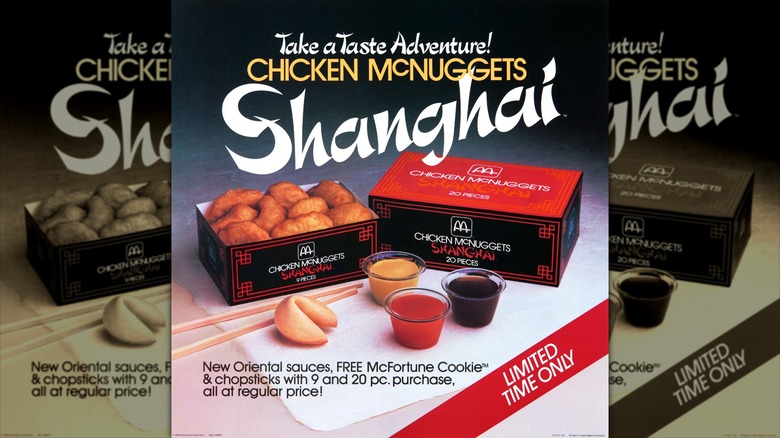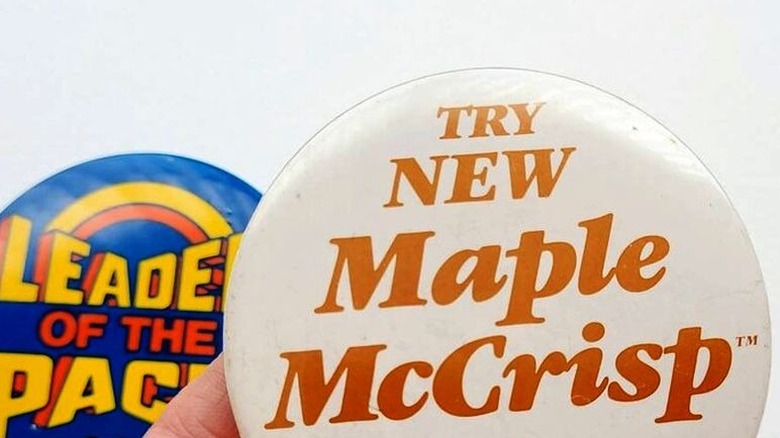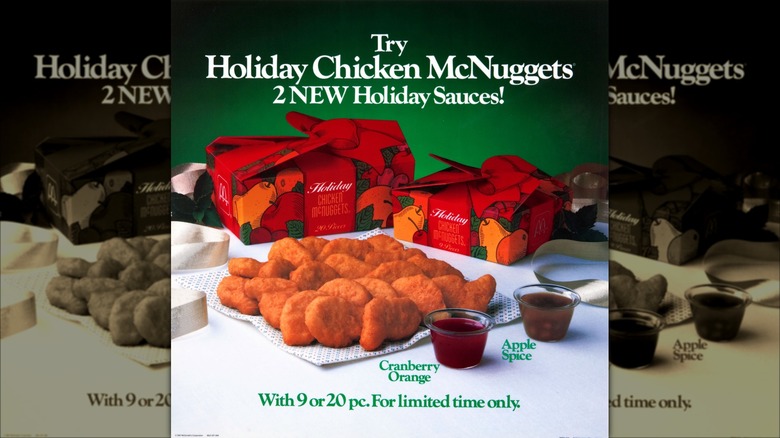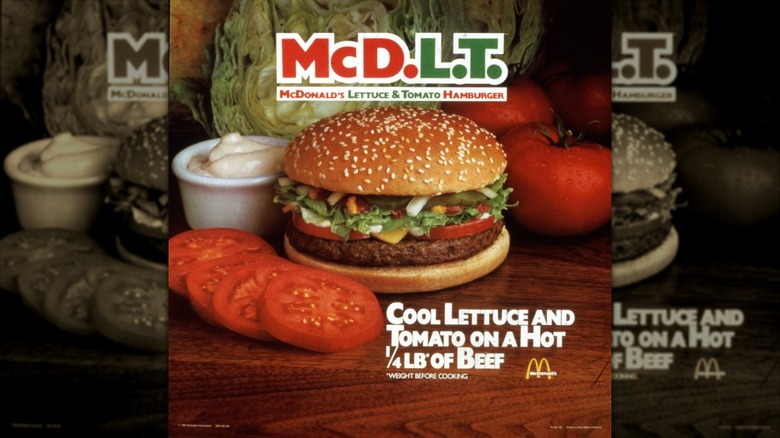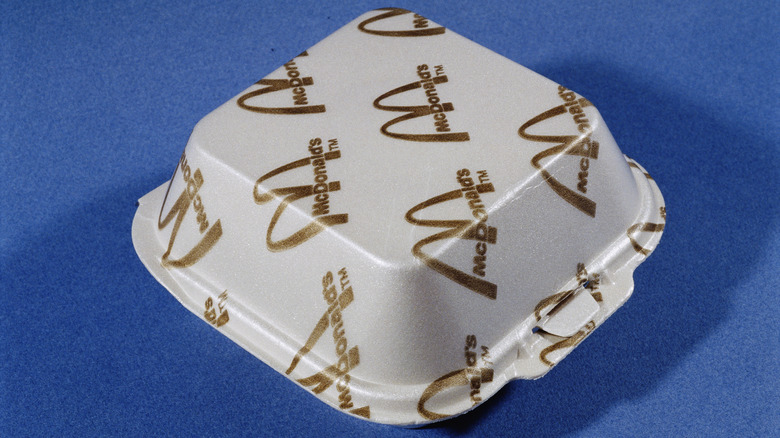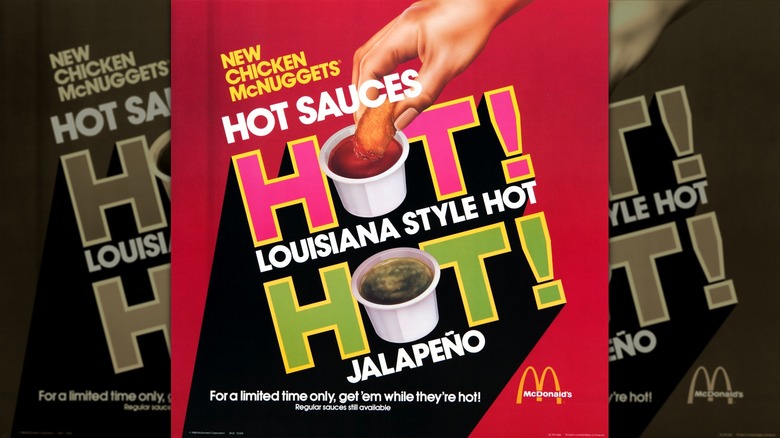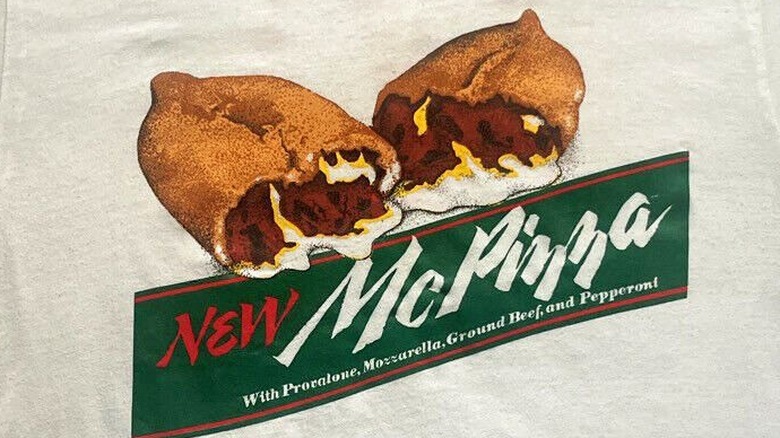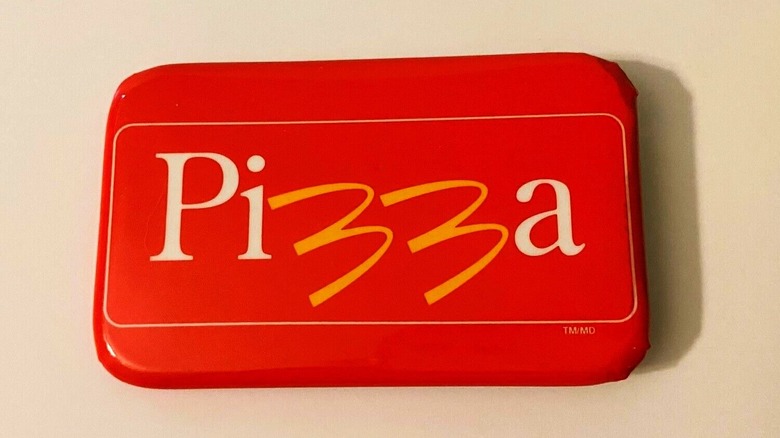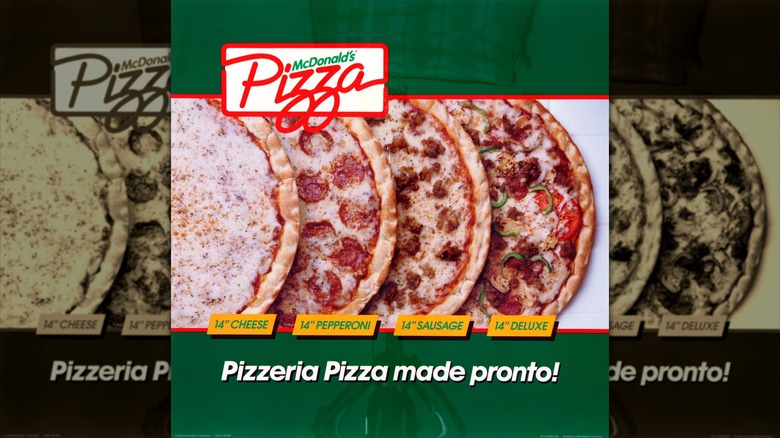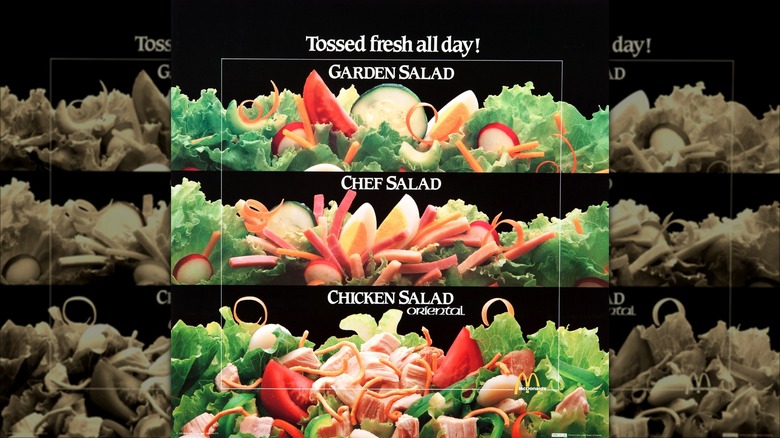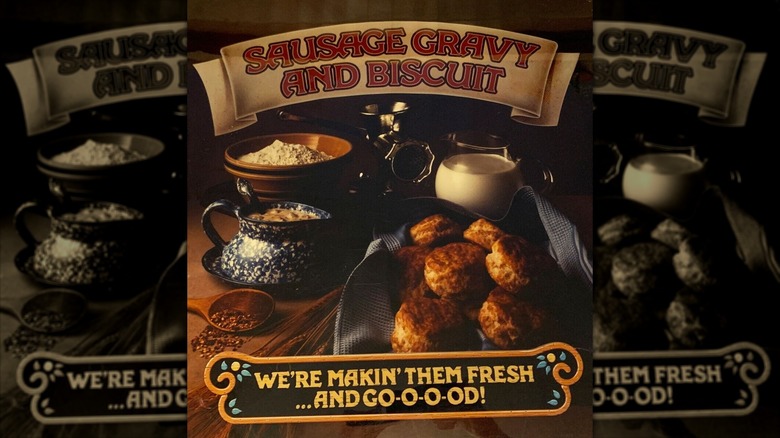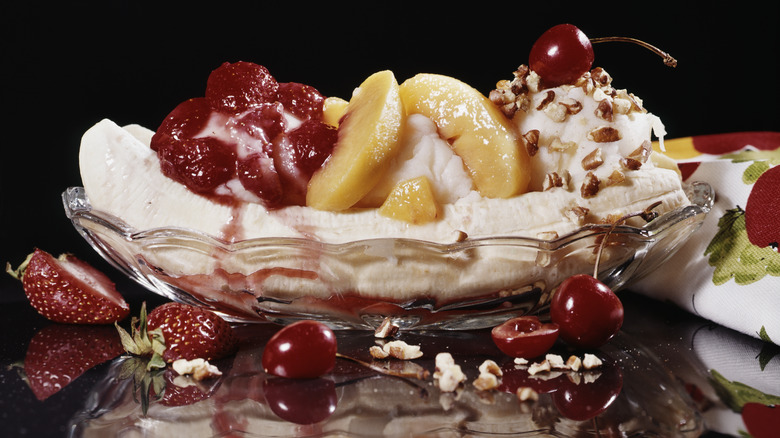17 McDonald's Menu Items From The 1980s You Probably Forgot About
The 1980s were quite a golden decade for the Golden Arches, thanks to executive chef René Arend. Under his tenure at the McDonald's corporation, which began in 1976 and lasted until 2004, the test kitchen was rife with experimentation and innovation. One of Arend's biggest hits was, of course, McDonald's famous Chicken McNuggets. Yet for every home run, there were plenty of big swings and misses in the 1980s. Corporate employee-turned-franchisee Gary Eckmann told The Bangor Daily News in 1988: "Only one idea in 200 ever gets to the point of being tested in the marketplace by consumers."
Some menu item ideas that made it into brick-and-mortar McDonald's restaurants in the 1980s are lovingly revered to this day. But many are long-forgotten, like the Styrofoam clamshell containers they once came in. To help remember them, we took a time machine back to the '80s to see what we missed out on. These items sought to bring freshness to breakfast, lunch, and dinner menus. They included stabs at unique dipping sauces, gourmet salads, Latin-inspired dishes, and even pizza. McEnjoy!
1. Caramel Pecan Roll
During the early '80s, as McDonald's was slowly rolling out its new sausage and egg biscuit and laying the foundation for the Sausage McMuffin, it was also trying out a new dessert. Around this time, McDonald's chef René Arend relayed to the St. Louis Post-Dispatch: "I'm also testing a caramel pecan roll in some other markets." By 1982, the freshly made Caramel Pecan Roll was added to the breakfast line-up.
This rounded pastry looked like a modern-day Cinnabon but with a generous amount of pecans on top. In advertisements, it was described by the company as: "Light and flaky with a hint of cinnamon ... and a crunchy-sweet topping of caramel and chopped pecans!" According to Arend, the Caramel Pecan Roll was one of the last items he and McDonald's chain maestro Ray Kroc dreamed up together, before the latter's passing in 1984 (via "Restaurants & Institutions").
This roll didn't seem to stay rolling beyond 1984, though. However, a cinnamon roll was eventually added to the menu and existed as part of the chain's McCafé Bakery options — alongside apple fritters and blueberry muffins — until the items were discontinued in 2023.
2. Cheddar Melt
In 1984, McDonald's went big with its first-ever ⅓-pound patty burger: the Cheddar Melt. The burger was topped with melty cheddar cheese sauce, grilled onions, and — in another Golden Arches first –housed in a rye bun. This whopper was tested in Indianapolis and Milwaukee, of which Robert Keyser, McDonald's public relations director, told The La Crosse Tribune: "People seem to like it, even though we have done no advance advertising."
After further testing in locations such as Utah and Canada, McDonald's was ready to take the item nationwide in 1988. But now, the patty was reduced to a ¼-pound size. During Super Bowl XXII, McDonald's bought air time to make a big announcement with a nearly silent commercial. The advertisement put the Cheddar Melt on display, letting the visuals and some text do all the talking. At the end of the ad, the last text line said: "Thank you for listening." Tom Shales, a television critic for The Washington Post at the time, called it the best ad aired during the entire night.
By the end of that first quarter of 1988, McDonald's saw an 18% increase in business from the year before, due in part to the success of the limited run of the Cheddar Melt. Customer demand brought it back several times, including a 1992 version that included bacon. The last known sighting was in 2014, for lucky eaters in parts of Pennsylvania, Wisconsin, and Michigan.
3. Chicken L.T.
During the middle of the 1980s, McDonald's started cooking up a new menu item featuring a grilled white meat chicken filet. At the time, company spokesperson Lana Ehrsam told The Herald News: "We are a consumer-driven company. McNuggets are very popular, so we are trying another way to serve chicken." In 1985, a trademark was filed by McDonald's for a dish called the Chicken L.T.
By March 1986, the Chicken L.T. was sent to McDonald's locations in select cities in Washington, Kentucky, and Pennsylvania for testing by the public. This item was also cooked up by chef René Arend.
One draw of this item was its low calorie count, at just under 300 per sandwich. In a TV ad for the item, a woman explains how she takes a break, from watching what appears to be a Jane Fonda workout video, to happily indulge in a Chicken L.T. In Washington during this time, some locations sold upwards of 150 to 200 a day. But not everyone was McBuying into its taste, and some people felt the filet tasted prefabricated and dry. The side of mayo didn't seem to help, and by the end of the year, Arend, with some help from Kraft, introduced three additional sauces to solve that issue: Hickory Barbeque, Honey Horseradish, and Light Mayonnaise. This item took its last breath in 1987, but it wasn't the last time McDonald's topped chicken with L. and T.
4. Quarter Pounder Ranchero
During the 1980s, Nelly and Dominic Quijano owned a Houston McDonald's. As owners, they noticed that McDonald's wasn't exactly catering to the tastes of the local Hispanic community. So, in 1985, they began testing a breakfast burrito for customers. Three years later, building on this trend, McDonald's released its Chicken McNugget Fiesta menu item. In July 1989, McDonald's went a step further, hoping to bring the party to lucky eaters in Ohio, Pennsylvania, New Mexico, Texas, and West Virginia. Those test markets served up ham or sausage burritos for breakfast, as well as a Mexican-inspired version of the Quarter Pounder for lunch and dinner.
The Quarter Pounder was first introduced in 1971 by Fremont, California, franchisee Al Bernardin. The Quarter Pounder Ranchero, which retailed for $1.79, started with the typical bun, beef patty, and lettuce, but was decked out with a tostada chip and red taco sauce with bits of pepper. One review in The Pittsburgh Press by Ann Butler noted: "It's too subtle. It needs zing." But she then added: "The Ranchero isn't bad. Spice it up, and it'd be better."
While a burrito eventually found a permanent place on McDonald's breakfast menu, the Quarter Pounder Ranchero proved to be a one-time wonder. The word "Ranchero" did resurface on McDonald's menu in 2001 with a Ranchero Bagel.
5. Chicken McNuggets Fiesta
After giving breakfast burritos and the Quarter Pounder Ranchero test runs, McDonald's decided to throw an even bigger "Fiesta" in 1988. This time around, McNuggets were the cause for celebration. Along for the ride were three new sauces, 30 million Latin American coins, and a tropical shake.
The fiesta kicked off on August 12, 1988, and lasted four weeks at specific locations, including McDonald's locations in Guam. Stores were decorated, and crew members dressed up in stereotypical garb. If a customer ordered a nine- or 20-piece McNugget meal, it came in a beautifully designed box that contained an actual coin from one of six Latin American countries, as well as three unique sauces: a zesty green chili salsa with jalapeño peppers, a mild salsa with chunks of tomato and onion, and a smoky-flavored mesquite barbecue sauce. While at the time, these seemed like unexpected flavors to be found within the confines of a McDonald's, today, packets of Hot or Mild Picante Sauce are always at the ready.
If that wasn't enough fun, a Fiesta Colada Shake was released to help bring down the temperature after dipping into those sauces. It was essentially a vanilla milkshake with coconut and pineapple flavoring. A television advertisement released at the time trumpeted the drink as: "delicious, different, cool" (via YouTube). It wasn't cool enough for an encore, but at least at McDonald's in Australia, you may be able to still get a piña colada-flavored soft serve.
6. Chicken McNuggets Shanghai
In August 1986, Madonna and Sean Penn starred in the film "Shanghai Surprise." Around the same time, Chicken McNuggets Shanghai launched. McDonald's spokesman Lana Ehrsam told The Miami Herald of the item: "We were just looking for another way to have some fun with McNuggets." The new McNuggets first saw the light of day in West Germany and Spokane, Washington, before going nationwide for five weeks. The McNuggets were housed in a red and black box. They came with a goodie bag that included chopsticks, a McFortune cookie, and special sauces (Teriyaki, Sweet and Sour, and Hot Mustard).
Seven different bakeries produced over 40 million McFortune Cookies for this run. The paper fortunes contained McWisdom such as: "All the world's a stage. Right now, it's intermission." Others said things like: "It is better to have loved a short person than never to have loved a tall," according to the Gannett News Service. An equal amount of chopsticks were also produced. This was reportedly about as much as would have been produced for all of McDonald's locations in South Korea at the time. In some locations, these McNuggets were so popular locations would run out of sauces.
This campaign flew north to Canada in the summer of 1987 and across the pond to England the year after. Its packaging earned its place (not in a positive light) at New York's Museum of Chinese in America, and even spawned a 1986 "Saturday Night Live" spoof.
7. Chicken McSwiss and Maple McCrisp
1984 was a busy year for McDonald's doing trial runs of products in select test markets. Two of the rarest items to see the light of day were the Chicken McSwiss and the Maple McCrisp.
For the breakfast menu, McDonald's tried to make a sweet square nugget a reality with its Maple McCrisp. McDonald's spokeswoman Stephanie Skurdy told The Record: "It tastes kind of like French toast. It's crisp on the outside and when you bite into it the syrup oozes out." This one didn't pan out either, but it sounded like a blessed mess.
The Chicken McSwiss was McDonald's attempt at a cordon bleu sandwich. About 20 Tennessee locations were selected as the testing grounds. Ads promoted that the item had "three tempting tastes in one piping hot sandwich," according to the Bristol Courier Herald. That trio consisted of a crispy piece of chicken, a slice of smoked ham, and a creamy slice of Swiss cheese. A year later, The Elizabethton Star asked chef René Arend about what happened to the Chicken McSwiss, to which he relayed that the popularity of the treat dwindled, leading to it being removed from the menu.
8. Certain holiday treats
When it comes to the holidays, McDonald's has long gotten into the spirit of the season to either warm up or cool down its customers with its food and drinks. Starting in 1987, the chain released its Holiday Chicken McNuggets, complete with an ornate box that appeared to have been gift-wrapped with a red bow. To truly differentiate these McNuggets, two new sauces were also introduced: Apple Spice and Cranberry Orange, which were also featured in the box's artwork.
Holiday Chicken McNuggets returned for the following two years. Canadian diners were lucky enough in 1988 and 1989 to have not one, but two truly festive dessert options to finish off their meals. The first was an Eggnog Shake, which McDonald's had introduced for a limited time as far back as 1970. The other was a Peppermint Sundae with a syrup so red that it could pass for fake movie blood.
9. McD.L.T.
Thanks to Texan franchisee Will May, in October 1984, two vegetables uncommonly found at McDonald's were put into play with the Lettuce & Tomato Special. Northeast Ohio and Shreveport, Louisiana, were the test markets, where ads promised fresh lettuce and tomato slices. These partnered with usual McDonald's toppings, like cheese, pickles, ketchup, and mayonnaise on a quarter-pound patty. So how did McDonald's ensure the fresh lettuce and tomatoes stay fresh? Thanks to the ingenuity of a Shreveport franchise location, a container with two sections was devised that separated the elements, allowing a "hot and juicy hamburger with cool and crispy condiments," as McDonald's Media Relations Manager Bob Keyser explained to The Akron Beacon Journal.
By the summer of 1985, as testing expanded to more markets, including Canada, the special burger received a new name: The McD.L.T. For the original markets where the Lettuce & Tomato Special started, ads implored customers to not call it by its old name. Advertisements spelled out the change as: "a fast, new way to say you want the same great combination," (via the Bryan Times). On television, future "Seinfeld" star Jason Alexander sang its praises in McDonald's commercials (via YouTube).
In 1990, bowing to public pressure, McDonald's announced a shift to paper wrappers. This move helped to bring about the McD.L.T.'s death, as there wasn't a fitting paper replacement for the unique clamshell that kept this item fresh. However, today shredded lettuce and tomatoes can be added to any sandwich.
10. Lite Mac
Many of McDonald's best and long-lasting innovations to its menu have come thanks to the experimentation of its franchise owners. One of the more prolific experimenters was Al Bernardin, who sprung the Quarter Pounder out of his Fremont, California, locations. While that was a big hit, there were of course some misses, like his ground turkey McGobbler, and a diet version of the Big Mac called the Lite Mac.
The Lite Mac was first put into mouths in November 1983. Compared to the Big Mac, it contained one less piece of bun, went lighter on the signature sauce, had a leaner single patty, and was 40% lower in calories. A spokesman for Bernardin's management then told The Cincinnati Enquirer: "People are looking for lighter foods and this may be one answer for us."
The Lite Mac was tested in five San Francisco area McDonald's and retailed at the same price as the genuine article ($1.29). It received mixed reviews from eaters and lagged in large sales, taking up only 3-8% of each location's totals. After a year, it didn't move beyond the initial test phase. McDonald's spokesperson Terri Capatosto then told The New York Times that it "just wasn't the taste our customers wanted."
11. Hot Jalapeño and Louisiana Style dipping sauces
When Chicken McNuggets launched nationwide in 1983, there were only four dipping sauces: Honey, Sweet and Sour, Hot Mustard, and BBQ. The following summer, McDonald's decided to spice things up and introduce some limited-release sauces. Until September 9 of that year, guests were able to pick up Hot Jalapeño or Louisiana Style dipping sauces, as well. The commercial released at the time said things like it's "a hot time for hot sauces," and "get them while they're hot," complete with very steamy imagery (via YouTube).
The Hot Jalapeño dipping sauce was similar to a salsa verde, while the Louisiana Style sauce was a cross between ketchup and classic Louisiana-style hot sauce. McDonald's would return to hot tastes many times thereafter. It did so with its Habanero Ranch, as well as its collaboration with the K-pop group BTS, which briefly gave eaters the options of Cajun and Sweet Chili dipping sauces. In 2020, McDonald's even released a spicy version of Chicken McNuggets.
12. McPizza (first version)
In 1985, McDonald's finally gave in to rolling in the dough — pizza dough that is. A Wilmington, Delaware, McDonald's was selected as one of the first locations to serve McPizza, along with nine other locations that tested it. This first iteration of the McPizza wasn't even in the shape of a typical pizza. This 99-cent item was more like a Hot Pocket or a calzone, filled with provolone and mozzarella cheeses, ground beef, pepperoni, onions, oregano, and tomato sauce, and housed in a paper box that resembled a pie or hash brown holder.
The initial goal was to see if the McPizza was a tasty hit with customers and if it could work within the McDonald's system without slowing down the production of other items. Speaking on this, McDonald's spokesperson Terri Capatosto told The Chicago Tribune: "We're basically testing to see if we can make a product like this. We're fundamentally a hamburger business and we want to see if our customers will want this in a big way."
The McPizza pies arrived frozen and were fried up on-site in slightly over four minutes. If they sat around longer than 10 minutes, they had to be thrown away. By 1986, testing had expanded to 60 McDonald's. But the brakes were slightly applied by Edward Rensi, president of McDonald's U.S.A. He told The Chicago Tribune: "In the long run, we're going to expand McPizza, but in the short run, we're going to concentrate on salads."
13. McPizza (second version)
After a couple of years of tinkering with the Hot Pocket-style McPizza, McDonald's turned to a more familiar shape. This second iteration of the pizza, released in 1987, was less of a snack and more of a personal pizza. It came in a 7-inch oval shape and was served in a plastic container.
Around 45 locations –spread out between Utah, Wyoming, Nevada, and South Carolina – got the first crack at the new pies. They came in two varieties: cheese for $1.15 and a sausage-pepperoni combo for $1.30. Both came in a handy box that was drive-thru friendly. The pies had similar ingredients to the calzone-like ones, outfitted with mozzarella, provolone, Parmesan cheeses, tomato sauce, herbs, and spices.
Bob Home, who operated a few Charleston-area McDonald's locations at the time, told The Charlotte Observer: "It's a good cheesy pizza, the sales are good." He also added: "And our employees like it, and they're pretty particular about what they eat."
14. McDonald's Pizza
In 1989, McDonald's locations in Evansville, Indiana, and Owensboro, Kentucky, were tapped as the pizzaiolos for a set of new 14-inch pies. However, this third incarnation, tested in those select stores by the chain, had a new name. Instead of McPizza, it was called McDonald's Pizza.
The pizzas were only available to order for dinner and came in four varieties: Cheese, Pepperoni, Sausage, and Deluxe. Crushed red pepper flakes and parmesan cheese were also available for sprinkling on top. They took five to 10 minutes to make and cost $5 to $9 per order. Test locations were remodeled to have pizza-ready ovens. The drive-thru windows even had to be lengthened so the pizza boxes would fit through them.
While the tests were localized, buzz started to build across America about the product that sold over 100,000 units in just four months. Even Pizza Hut took notice and ran snarky "McFrozen" ads to try to talk the air out of McDonald's crust. It seemed a nationwide release was in the cards in the 1990s. But only Canada got the full green light in 1992. While it was officially discontinued in 1996, a McDonald's in Spencer, West Virginia, and another in Pomeroy, Ohio, continued to serve the pies, until the ovens were forced off in 2017.
15. A handful of specific salads
To keep pace with rivals Wendy's and Burger King, McDonald's tried to make salad bars a thing. They did so beginning in 1974 but shifted focus to individually packaged salads by 1984. Robert Keyser, director of media relations for McDonald's, told The Washington Post: "We don't look back at the competition. We see no need to get into the battle for second place."
Five salads made the rounds starting in 1985. The Garden Salad — which was apparently tossed fresh each day – consisted of iceberg lettuce, celery, carrot, radish, cucumber, egg, tomato, and cheddar cheese. The Chef Salad and Shrimp Salad were similar. However, the former was topped off with strips of turkey and ham, while the latter was topped with shrimp. The Chicken Salad Oriental featured chunks of chicken, water chestnuts, crunchy chow mein noodles, and dressing. The Pasta Salad consisted of rotini noodles, ham, celery, carrots, green peppers, onions, tomatoes, parmesan cheese, and a packet of teriyaki dressing. Other salad dressing options included French dressing, Thousand Island dressing, blue cheese dressing, and a light vinaigrette. Bacon bits and croutons were also available upon request.
While these salads didn't last, McDonald's has continued to try greener items since, like the short-lived and novelty McSalad Shakers. More premium options came about in the 21st century, like Caesar and Cobb salads. But eventually, the COVID-19 pandemic brought about the fall of McDonald's salads.
16. Two biscuit options
One particular breaded item served as a canvas for multiple trial products for McDonald's breakfast: biscuits. Food technologist Ginnie Judd of Griffith Labs helped come up with the recipe. She told the Kingsport Times-News: "Well it's pretty much your normal biscuit recipe with flour, baking soda, and shortening. We just kept tinkering with it to get it just right."
In 1980, looking to branch out from biscuits just being used as buns for breakfast sandwiches, McDonald's tried out Breakfast Biscuits. They came with Southern-style ham or a pork sausage patty. And notably, they came without cheese. Bacon later joined the menu as a McDonald's biscuit meat. To this day, both sausage and bacon biscuit sandwiches can still be found on the menu.
By 1987, McDonald's attempted to do something with its biscuits outside of the sandwich realm. States like Indiana and South Carolina hosted the new Sausage Gravy and Biscuit, as well as the Cinnamon Raisin Biscuit. The homestyle gravy contained pork sausage, while the sweeter one had a light glaze to keep the raisins and cinnamon in place. These days, if you're looking to recapture these bygone sweet and savory biscuit offerings, your best bet is to head to a Bojangles or Hardee's.
17. Sundae Split
McDonald's and ice cream have had a long and delicious partnership, from shakes to cones to the McFlurry. One lesser-known item that once dotted the dessert menu was the Sundae Split, which first came into this world in 1989. McDonald's could have just called this a banana split, but it went through the trouble to trademark the unique name Sundae Split instead.
At only 99 cents, the Sundae Split offered great value for ice cream lovers who didn't want to bother hitting up a Dairy Queen location after their McDonald's meal. In a plastic tray, a mound of soft serve ice cream was used as the canvas for whipped cream, banana halves, and classic McDonald's toppings such as hot fudge, hot caramel, and strawberry. If that wasn't enough, of course, there was room for a cherry on top. This hung around at least into 1990 before becoming a forgotten relic.
